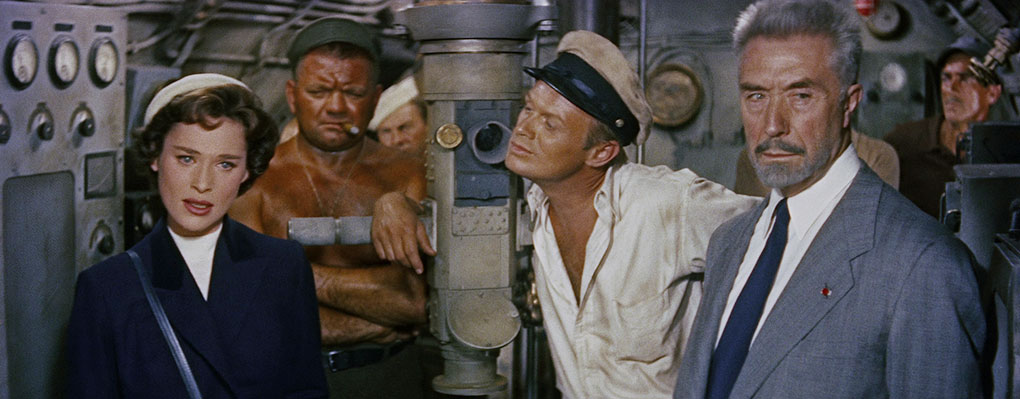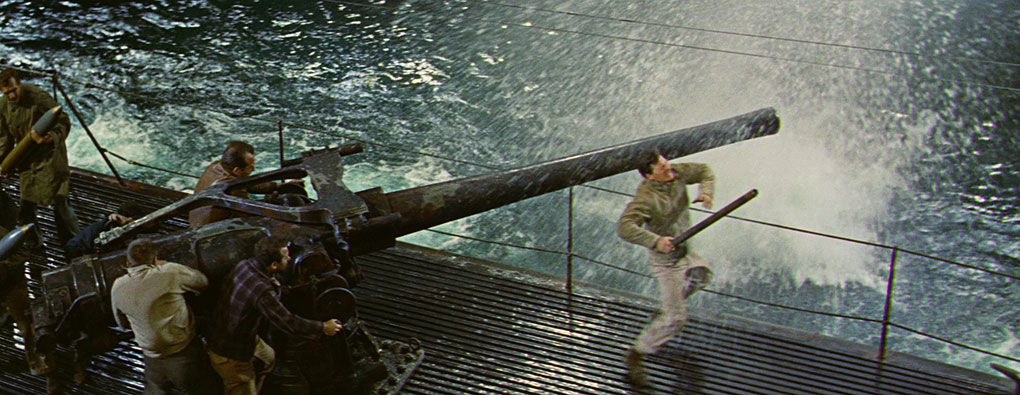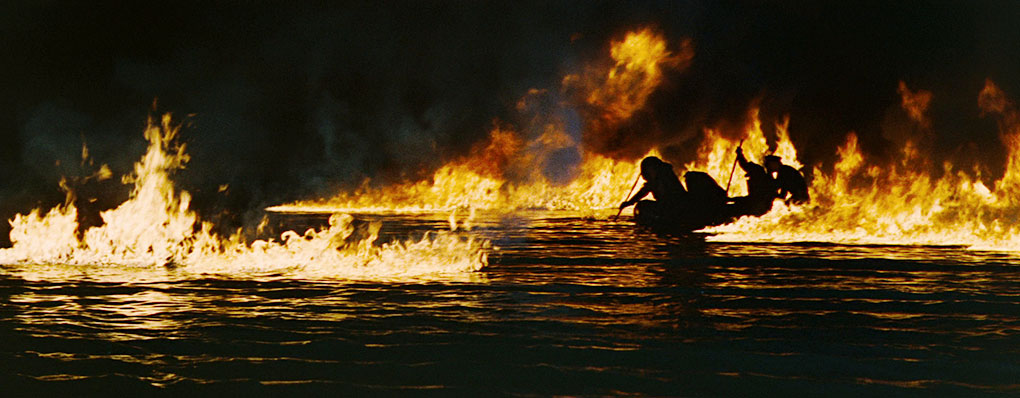Note: This disc is only available at present as part of Eureka's Fuller at Fox, Five Films 1951-1957 box set.
No-one could exude cynical self-interest quite like Richard Widmark, and if his Oscar-nominated feature film debut as Tommy Udo in the 1947 Kiss of Death is anything to go by, no-one could play a ruthless bastard quite like him either. It's these traits that were responsible for the only real blot on the otherwise thrilling copybook of Michael Crichton's 1978 medical thriller Coma, as casting Widmark as the hospital’s chief surgeon and expecting the audience not to twig that he's bad guy was frankly asking too much. It's a fine performance, but from moment he puts in his first appearance I just knew he was not a man in which anyone should place their trust.
But for now let's stick to playing cynical, and if you want to see Widmark perform this one to perfection then I urge you to hunt out Samuel Fuller's terrific 1953 Pickup on South Street. In it Widmark plays pickpocket Skip McCoy, who by chance lifts a stolen microfilm that's on its way to enemy hands and, ignoring appeals to his patriotism, kicks off a bidding war between the US authorities and their Communist foes. The following year Fuller directed Hell and High Water, which again sees Widmark cast as a bit of a cynic in a Cold War climate. Here he plays ex-submarine Captain turned mercenary Adam Jones, who is hired by a privately financed international group to transport two of their number – French nuclear scientist Professor Montel (Victor Francen) and his beautiful daughter Denise Gerard (Bella Darvi), who doubles as his assistant – to an Alaskan island in order to investigate possible communist evil dealings involving nuclear weapons.

Despite the possibilities offered by this setup, Hell and High Water is definitely more adventure yarn than political thriller. This is most blatantly illustrated by the character of Denise Gerard, who is not only devilishly good-looking but smart as a whip, able to fluently speak and read every language she encounters and absolutely committed to her father’s cause. None of this stops Jones's hand-picked crew from falling over themselves to impress or even hit on her, or Jones himself from snogging her when the going gets tough. More than anything else in the film, this aspect has not aged well.
It could be argued that Hell and High Water re-treads ground covered by Fuller's 1951 Fixed Bayonets! in the moral awakening of its central character, but the politics that were kept largely irrelevant in the earlier film are brought more bluntly to the fore here. From a modern perspective the reading seems clear, with the well-meaning but ultimately ineffectual multi-national group intended to as a representation of the United Nations – or at least the still too common right-wing American view of it – a body that carries out investigations but that, even in the face of potential international catastrophe, refuses to take military action, something that is left to the bullish American naval commander to initiate. The film’s final act could even be read as a call for the UN and for apolitical Americans to wake up and get with the programme, to realise that the Reds are out there and that they're plotting against us and that the free world needs to get off its ass and damned well do something to stop them. All of which feels a just a tad crude and simplistic today, with the message sometimes hammered home by Alfred Newman’s score, which intermittently hits heroic heights worthy of John Phillip Sousa, giving a couple of scenes an air of Doc Savage-like parody.
Where the film does tend to shine is in the character detail and the handling of individual scenes, a highlight being the stand-off with a Chinese submarine in a waiting game that gradually robs the crew of air, a tense and memorable sequence with a somewhat unlikely conclusion. The crew camaraderie is also a typical Fuller strong aspect and he appears to delight in their multiculturalism, with subtitle-free exchanges held in a number of languages and a self-sacrificing Chinese crew member included to help paint the enemy in ideological rather than racial colours.

As you would expect with Fuller, the action is well handled, with a vigorous land-based gun battle in which the bullet traces are visible and a striking image of crew members paddling through a sea of fire. There are also a smattering of tough character moments (one character is beaten to death with a spanner, another has his thumb hurriedly amputated when it becomes jammed in the topside hatch as the submarine is diving) that remind you who is in the director's chair. Fuller also makes effective use of the CinemaScope frame and keeps his camera on the move, which contributes to the film’s unwaveringly brisk pacing, and the submarine model work is never less than exemplary. Yet despite these genuine qualities, this cheerful wandering Boy’s Own Adventure territory is, for me at least, several notches short of top-drawer Fuller, and the director himself later described as his least favourite picture. There are still enough distinctive elements here to fire the interest of Fuller devotees, however, and fans of submarine-based adventure tales should find plenty here to keep them happy.
Having been shot in CinemaScope (check out the trailer if you have any doubts), the transfer here is appropriately framed at 2.55:1 and while strong in some ways, falls a little shy of greatness. It certainly improves on the film’s earlier DVD incarnation, with a sharper and more detailed image and black levels that do not have the unsightly blueish tinge visible in some scenes on Optimum’s DVD, black levels that here do tend to suck in more picture detail than I'm guessing was intended. The colour often has a slightly artificial hue, though the sequences in which the submarine interior is bathed in red light are rendered vividly and without any banding or colour bleeding. No damage is visible and dust spots are rare.
The Linear PCM 2.0 stereo track may not have the dynamic range of a more modern film, but the dialogue is clear and the sound effects of battle have a pleasing heft. The channel separation is subtle, but detectable.
Optional English subtitles for the deaf and hearing impaired have been included.
Audio Commentary by Scott Harrison
Author and film critic Scott Harrison delivers a fascinating commentary on what he freely admits is one of his favourite Sam Fuller films and that he even describes as "an absolute classic," a point on which I think we can agree to disagree. It matters not, as Harrison doesn’t spend his time gushing over the film but instead providing a wealth of background information on its production and the Cold War politics against which it was made and set. He goes into considerable detail on this and cites a few relevant historical incidents, all of which should prove particularly helpful to those not well versed in the politics of the period. He recalls the days of pan-and-scan TV and VHS transfers, and makes an impassioned case for why model work and matte paintings are preferable to CGI. He also addresses some of the criticisms of the film with an impressively level head, accepting some and thoughtfully contextualising others.

Richard Widmark: Strength of Characters (44:23)
What looks like a production for the Biography Channel provides a comprehensive overview of Widmark’s life and career, but does so in a manner of fawning awards ceremony tribute, complete with heroic background music and the sort of narrator that you can’t imagine ever had a bad word to say about anyone. Includes interviews with Widmark, his daughter Anne and actors Karl Malden and Robert Wagner, plus extracts from many of his films.
Trailer (2:03)
If you had any doubt that the film was shot in CinemaScope then this trailer – which passes up no opportunity to blaze the word across the screen or the soundtrack – will put you right. Mind you, given how wonderful we are assured that the process is ("the modern miracle you can see without special glasses!"), you’d think they’d include at least one extract from what was one of the first films to be shot using this process instead of stringing together a series of painted stills.
Booklet
As this disc is only being released as part of the Fuller at Fox, Five Films 1951-1957 box set, there is a single booklet that covers all five films, but it is handily chaptered by the movies themselves. The lead essay in the section on Hell and High Water is a substantial and enthralling one written by Philip Kemp, which looks at Fuller the filmmaker and does discuss this film, but focusses more on his follow-up features, House of Bamboo and China Gate. This is followed by a posthumously published piece by Fuller in which he makes some interesting comments about his approach to shooting the film and the experience of making it. Intriguingly, he describes his own rewrite of the original script as turning it "into a stylized, cartoonish tale" akin to Steven Spielberg’s later Raiders of the Lost Ark. He also confirms a story told elsewhere about Spielberg showing him that he kept a print of Hell and High Water in the trunk of his car as reference material when filming his sprawling war comedy, 1941. The main credits for the film have also been included.
Of the five films in this set, this is, in the words of its director, my least favourite, but there’s still enough of real interest here to make it worth seeing, particularly if you are a fan of this director, and submarine movie devotees should have a ball. There are weaknesses in the otherwise solid transfer, though it definitely improves on the previous DVD, while the special features alone would make it easy to recommend were this a stand-alone release.
|